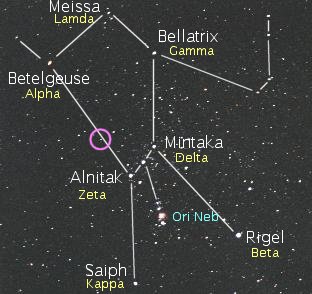

THE PLANETThe circle shows the location of the class G star HR 1988, found in the constellation Orion, is orbited by not one, but two planets. The inner of the pair has mass at least 0.78 times the mass of Jupiter. Like so many other planets of nearby stars, it is tucked up close to its parent at a distance of only 0.13 Astronomical Units (19 million kilometers, or 33% the distance between the Sun and Mercury), causing it to orbit in a mere 14.3 days (16% of Mercury's orbital period). Even though close to its star, its orbital eccentricity is fairly high, the planet going as far from the star as 0.17 AU and as close as 0.09 AU. The outer of the two planets has a much larger mass of 12.7 Jupiters, which makes it close to being a deuterium (heavy hydrogen) fusing brown dwarf and perhaps not a planet at all. The big one orbits in 5.95 years at a mean distance from the star of 3.68 AU (going from 2.4 to 5.0 AU over its "year"). |